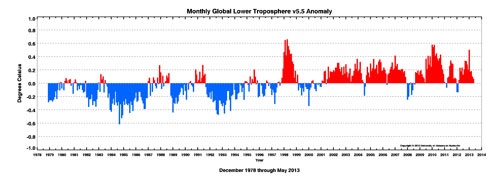| Jun 05, 2013 |
Global climate trend since Nov. 16, 1978: +0.14 C per decade
|
|
(Nanowerk News) Global average temperatures and the tropics continued a slow cooling drift in May, downward from a warm January, said Dr. John Christy, a professor of atmospheric science and director of the Earth System Science Center (ESSC) at The University of Alabama in Huntsville.
|
|
Compared to seasonal norms, during May the coldest area on the globe was in northern Greenland, where the average temperature was as much as 3.75 C (about 6.7 degrees Fahrenheit) cooler than seasonal norms. Compared to seasonal norms, the “warmest” area on the globe in May was in the northern Siberia. Temperatures there were as much as 3.91 C (about 7.0 degrees Fahrenheit) warmer than seasonal norms for May.
|
 |
| Monthly Global Lower Troposphere 5.5 Anomaly. (click image to enlarge)
|
|
Global climate trend since Nov. 16, 1978: +0.14 C per decade
|
|
May temperatures (preliminary)
|
|
Global composite temp.: +0.07 C (about 0.13 degrees Fahrenheit) above 30-year average for May.
|
|
Northern Hemisphere: +0.16 C (about 0.29 degrees Fahrenheit) above 30-year average for May.
|
|
Southern Hemisphere: -0.01 C (about 0.02 degrees Fahrenheit) below 30-year average for May.
|
|
Tropics: +0.11 C (about 0.20 degrees Fahrenheit) above 30-year average for May.
|
|
April temperatures (revised)
|
|
Global Composite: +0.10 C above 30-year average
|
|
Northern Hemisphere: +0.12 C above 30-year average
|
|
Southern Hemisphere: +0.09 C above 30-year average
|
|
Tropics: +0.17 C above 30-year average
|
|
(All temperature anomalies are based on a 30-year average (1981-2010) for the month reported.)
|
|
Archived color maps of local temperature anomalies are available on-line at http://nsstc.uah.edu/climate/
|
|
The processed temperature data is available on-line at vortex.nsstc.uah.edu/data/msu/t2lt/uahncdc.lt
|
|
As part of an ongoing joint project between UAHuntsville, NOAA and NASA, Christy and Dr. Roy Spencer, an ESSC principal scientist, use data gathered by advanced microwave sounding units on NOAA and NASA satellites to get accurate temperature readings for almost all regions of the Earth. This includes remote desert, ocean and rain forest areas where reliable climate data are not otherwise available.
|
|
The satellite-based instruments measure the temperature of the atmosphere from the surface up to an altitude of about eight kilometers above sea level. Once the monthly temperature data is collected and processed, it is placed in a "public" computer file for immediate access by atmospheric scientists in the U.S. and abroad.
|
|
Neither Christy nor Spencer receives any research support or funding from oil, coal or industrial companies or organizations, or from any private or special interest groups. All of their climate research funding comes from federal and state grants or contracts.
|

